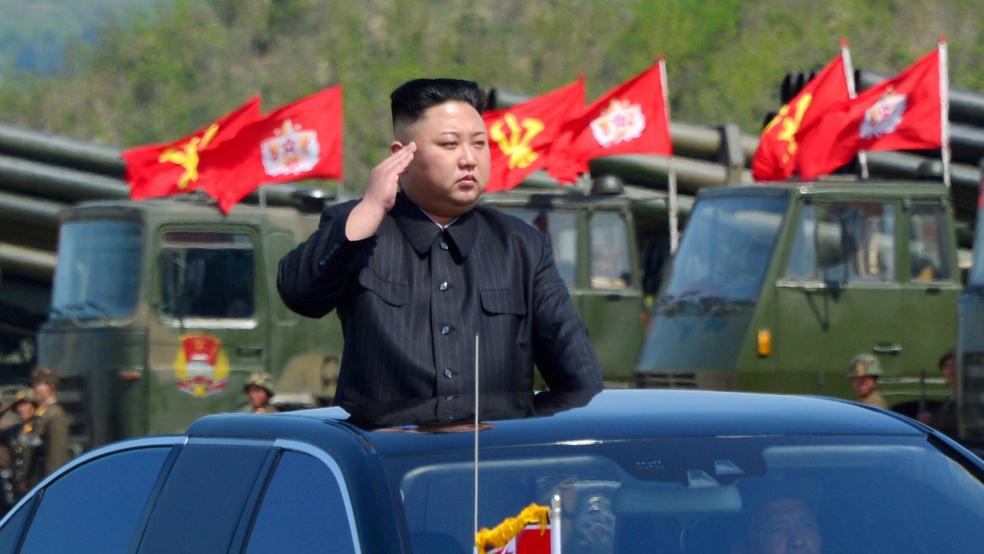The supercharged threats volleyed between President Trump and Kim Jong Un this week bring us closer to war with the North Korea than at any time since Pyongyang tested its first nuclear device in 2006.
If you live in Los Angeles—or Guam, South Korea, Japan, or Northeast China—you’re at least thinking about thinking the unthinkable. But it’s important to understand this crisis for what it is and isn’t as of this week.
First, it is an ugly war of words between two people given to bombast, and it isn’t likely to escalate much beyond one. Neither Kim nor Trump is as crazy as a lot of people assume.
Related: Here’s Why North Korea Put Guam In Its Crosshairs
Second, Trump’s tough talk comes at a price. It’s eroding confidence among U.S. allies in Asia, not building it.
Third, the hyper-hostile rhetoric actually suggests Washington and Pyongyang are headed toward negotiations. This kind of bluster is almost always part of the complex dance that precedes all talks meant to resolve crises.
When the Security Council voted 15–0 on a severe new set of sanctions against North Korea last weekend, it was every bit the “gut punch” Nikki Haley, Trump’s ambassador to the U.N., said it was. Multilateral gang-ups with everyone on board give Pyongyang an especially sharp sting, North Korea experts say.
But the big event came Tuesday when Trump responded to Kim’s bitter denunciation of the sanctions. “North Korea best not to make any more threats to the U.S.,” Trump said at his New Jersey estate. “They will be met with fire and fury like the world has never seen.”
Since then the always-confrontational Kim has been on a tear. In a statement Wednesday, the North Korean leader called Trump’s fire-and-fury remark “a load of nonsense.” Kim also promised to ignite an “historic enveloping fire” by launching four missiles at Guam, the U.S. possession in the Pacific, in a week’s time.
Related: Tillerson: Trump's Tough Talk Aims to Send Message to North Korea
It’s closer to a two-way rant than a level exchange of considered intentions. But that doesn’t mean there’s no danger in it. These are two heads of state, and neither is known for taking the subtle approach.
But pre-talks preparation is still the name of the game here.
On Kim’s side, threatening to hit Guam with medium-grade missiles is high-visibility positioning for negotiations he expects to enter down the road. They remain the only plausible solution to the Korea crisis, and the 33-year-old Kim knows this as well as anyone else. Kim wants a few things from any such talks. The North has craved U.S. recognition for decades. That’s unlikely to get off the wish list, but Kim’s sure to demand it.
There are economic enticements, too. Russia has been preparing for eventual talks for several years. It has signed a debt-forgiveness agreement with Pyongyang and proposes building a gas pipeline from Siberia through North Korea and into the South. That will be the economic backbone of any settlement.
Related: China Seethes on Sidelines Amid Latest North Korea Crisis
Kim will also ask for security guarantees and substantial economic aid. Remember, Kim’s father, Jong-il, negotiated just such conditions with Bill Clinton in the mid-1990s, and they were nice while they lasted (which was briefly).
Advancing his missile and nuclear programs while pushing his chest out as far as possible are Kim’s best and only shots when he sits down at a table to face the U.S. That’s what he’s doing now.
On the U.S. side, there are some big, urgent decisions to make. At the moment, the administration is exceedingly divided on foreign policy—not a strong starting point if we’re on the way to negotiations. For one thing, what’s Washington going to do when this latest set of sanctions turns out to be only marginally more effective than those already in place? Trump’s people better figure this out, because it’s almost certain to prove the case.
For another, the commander-in-chief is making biblical threats to annihilate North Korea while Defense Secretary Mattis describes the North as an urgent military threat and Secretary of State Tillerson roams the globe telling people to “sleep well at night.”
Related: Futures Lower as North Korea Tensions Extend to Third Day
Unless Trump and Tillerson are playing a good cop–bad cop routine — unlikely but possible — it’s now urgent to get beyond this disunity: As long as it continues, not even U.S. allies can possibly figure out what the U.S. is going to do, to say nothing of the Chinese or North Koreans.
The right thing to do is negotiate, as Tillerson advocates. He’s got one big fix to make: You can’t make dismantling the North’s missile and nuclear programs a precondition of talks on that very question.
The Trump administration’s dithering and inconsistency on North Korea have already incurred costs. With his bombastic rhetoric, he’s risking the kind of damage to our Pacific relationships that he’s already caused across the Atlantic.
Given the North’s frequent tests this year and reported progress toward miniaturizing a nuclear device to warhead size, Kim is trying to push Trump to come to the table by leveraging the only asset he has. But it’s a lesson others might learn only too well: The best way to gain an advantage with the Americans is to get a nuclear program going.
That perception, if it spreads, will be regrettable collateral damage. But it’s no reason to avoid negotiations to defuse the mounting danger of confrontation on the Korean Peninsula as quickly as possible.
This week will be recorded in history books alongside the Cuban missile crisis. Wisdom prevailed back in the autumn of 1962. One way or another, it will this time, too.






